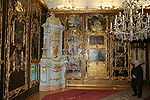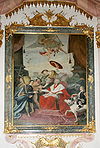
Leopoldskron
Encyclopedia


Rococo
Rococo , also referred to as "Late Baroque", is an 18th-century style which developed as Baroque artists gave up their symmetry and became increasingly ornate, florid, and playful...
palace and a national historic monument in Leopoldskron-Moos, a southern district of the city of Salzburg
Salzburg
-Population development:In 1935, the population significantly increased when Salzburg absorbed adjacent municipalities. After World War II, numerous refugees found a new home in the city. New residential space was created for American soldiers of the postwar Occupation, and could be used for...
, Austria
Austria
Austria , officially the Republic of Austria , is a landlocked country of roughly 8.4 million people in Central Europe. It is bordered by the Czech Republic and Germany to the north, Slovakia and Hungary to the east, Slovenia and Italy to the south, and Switzerland and Liechtenstein to the...
. The palace is located on the lake Leopoldskroner Weiher. Leopoldskron-Moos, an affluent residential area, reaches to the foot of the 1853m high Untersberg
Untersberg
The Untersberg is a mountain massif of the Berchtesgaden Alps that straddles the border between Berchtesgaden, Germany and Salzburg, Austria.The mountain is popular with tourists due to its proximity to the city of Salzburg: less than 16 km to the north and within easy reach by bus, for...
and features a number of still working farms as well as a peat
Peat
Peat is an accumulation of partially decayed vegetation matter or histosol. Peat forms in wetland bogs, moors, muskegs, pocosins, mires, and peat swamp forests. Peat is harvested as an important source of fuel in certain parts of the world...
-bog
Bog
A bog, quagmire or mire is a wetland that accumulates acidic peat, a deposit of dead plant material—often mosses or, in Arctic climates, lichens....
. The palace has been home to the Salzburg Global Seminar since 1947.
History
Prince-Archbishop of Salzburg Count Leopold Anton Eleutherius von Firmian (1679-1744) commissioned the palace in 1736 on the shores of an already existing pond after he had enriched himself in the process of expelling over 22,000 Protestants from Salzburg. He acquired the area between the palace and the Untersberg as a family estate which he passed on in May 1744 to his nephew Count Laktanz Firmian, who used it to house his large collection of paintings, which included works of TitianTitian
Tiziano Vecelli or Tiziano Vecellio Tiziano Vecelli or Tiziano Vecellio Tiziano Vecelli or Tiziano Vecellio (c. 1488/1490 – 27 August 1576 better known as Titian was an Italian painter, the most important member of the 16th-century Venetian school. He was born in Pieve di Cadore, near...
, Dürer, Poussin
Nicolas Poussin
Nicolas Poussin was a French painter in the classical style. His work predominantly features clarity, logic, and order, and favors line over color. His work serves as an alternative to the dominant Baroque style of the 17th century...
, Rubens and Rembrandt.
After the death of the Archbishop in 1744 his heart was buried in the chapel of the palace, while the rest of his body was placed in the cathedral of Salzburg. The palace stayed in the possession of the Firmian family until 1837, even after the death of Count Laktanz in 1786. It was then sold to the owner of a local shooting gallery, George Zierer, who stripped the palace of most of the valuable interior decorations, including paintings, etchings, and sculptures.
The palace had several owners during the 19th century (including a banker and two waiters who wanted to use it as a hotel, King Ludwig I. of Bavaria) until it was bought in 1918 by the famous theatre director Max Reinhardt
Max Reinhardt (theatre director)
----Max Reinhardt was an Austrian theater and film director and actor.-Biography:...
, co-founder of the Salzburg Festival
Salzburg Festival
The Salzburg Festival is a prominent festival of music and drama established in 1920. It is held each summer within the Austrian town of Salzburg, the birthplace of Wolfgang Amadeus Mozart...
. By this time the palace was in urgent need of repair. With the help of local artisans Reinhardt spent twenty years revitalizing the palace. Besides renovating the staircase, the Great Hall, and the Marble Hall, he created the Library, the Venetian Room, and a garden theatre. He used the whole building for his theatre productions (the audiences had to move from room to room) and as gathering place for writers, actors, composers, and designers from across the globe.
While Reinhardt was in Hollywood during World War II
World War II
World War II, or the Second World War , was a global conflict lasting from 1939 to 1945, involving most of the world's nations—including all of the great powers—eventually forming two opposing military alliances: the Allies and the Axis...
the palace was confiscated as a national treasure and "Jewish property". Reinhardt himself, however, never returned and died in 1943 in New York
New York
New York is a state in the Northeastern region of the United States. It is the nation's third most populous state. New York is bordered by New Jersey and Pennsylvania to the south, and by Connecticut, Massachusetts and Vermont to the east...
. During the same year, the estate was turned over by Hermann Göring
Hermann Göring
Hermann Wilhelm Göring, was a German politician, military leader, and a leading member of the Nazi Party. He was a veteran of World War I as an ace fighter pilot, and a recipient of the coveted Pour le Mérite, also known as "The Blue Max"...
to Stephanie von Hohenlohe
Stephanie von Hohenlohe
Princess Stephanie Julianne von Hohenlohe was a member of a German princely family by marriage and a close friend of Adolf Hitler who spied for Nazi Germany.-Early life:...
who was given the assignment of transforming it into a guest house for prominent artists of the Reich and to serve as a reception facility to Hitler's Berghof
Berghof (Hitler)
The Berghof was Adolf Hitler's home in the Obersalzberg of the Bavarian Alps near Berchtesgaden, Bavaria, Germany. Other than the Wolfsschanze in East Prussia, Hitler spent more time at the Berghof than anywhere else during World War II. It was also one of the most widely known of Hitler's...
home. The property was later returned to the Reinhardt estate.
After the war the palace was used by the Salzburg Seminar
Salzburg Seminar
Salzburg Global Seminar is an American non-profit organization that holds seminars on economics, politics, and other issues for future political, economic, and business leaders from around the world...
after it was offered in 1946 by Helene Thimig, the widow of Max Reinhardt, to Clemens Heller who founded the "Marshall Plan
Marshall Plan
The Marshall Plan was the large-scale American program to aid Europe where the United States gave monetary support to help rebuild European economies after the end of World War II in order to combat the spread of Soviet communism. The plan was in operation for four years beginning in April 1948...
of the Mind" together with Scott Elledge and Richard Campbell, all Harvard graduate students . The Salzburg Seminar originally offered education on American history, art, literature, and culture and was later transformed into a "global forum". The first session took place in 1947, and has been followed since then by more than 400 sessions on a wide variety of issues.
In 1959 the Salzburg Global Seminar purchased the palace and in 1973 the adjacent Meierhof, a part of the original Firmian estate. Extensive renovations and restorations also allow the palace to be used as a conference center and venue for events beyond the sessions of the Salzburg Seminar.
 |
 |
 |
 |
The Sound of Music
In 1965 the film The Sound of MusicThe Sound of Music (film)
Rodgers and Hammerstein's The Sound of Music is a 1965 American musical film directed by Robert Wise and starring Julie Andrews and Christopher Plummer. The film is based on the Broadway musical The Sound of Music, with songs written by Richard Rodgers and Oscar Hammerstein II, and with the musical...
, directed by Robert Wise
Robert Wise
Robert Earl Wise was an American sound effects editor, film editor, film producer and director...
and starring Julie Andrews
Julie Andrews
Dame Julia Elizabeth Andrews, DBE is an English film and stage actress, singer, and author. She is the recipient of Golden Globe, Emmy, Grammy, BAFTA, People's Choice Award, Theatre World Award, Screen Actors Guild and Academy Award honors...
, was produced in Salzburg with the grounds adjacent to those of Schloss Leopoldskron as one of the main locations. The palace was never used as the back of the Von Trapp
Von Trapp
Von Trapp could refer to:* Georg Ludwig von Trapp and Maria von Trapp of the Trapp family * The von Trapp Children, great-grandchildren of Georg and Maria von Trapp...
villa, although even some tours of Salzburg claim that it is. Scenes filmed on the adjacent property (known as Bertelsmann, at the time), include the family drinking pink lemonade ("not too sweet, not too sour, just too... pink!") on the terrace, Maria
Maria von Trapp
Maria Augusta von Trapp , also known as Baroness Maria von Trapp, was the stepmother and matriarch of the Trapp Family Singers...
and the Captain arguing on the terrace, and the children falling off the boat in the lake. Only shots showing the lake, were filmed there, using a replica of Leopoldskron's terrace, and horse-gates, leading to the lake. Any shots showing the building itself, were filmed at Schloss Frohnburg. The ballroom for the interior shootings, which were done in a studio, is a copy of the Venetian room from the palace.
The setting for the two main love scenes, one between Liesl and Rolf (featuring the song Sixteen Going on Seventeen) and the other between Maria and the Captain (Something Good) was the glass gazebo
Gazebo
A gazebo is a pavilion structure, sometimes octagonal, that may be built, in parks, gardens, and spacious public areas. Gazebos are freestanding or attached to a garden wall, roofed, and open on all sides; they provide shade, shelter, ornamental features in a landscape, and a place to rest...
originally situated in the garden of the palace. The gazebo interiors were shot on a Hollywood sound stage, only long shots of the Austrian gazebo are seen in the film. The gazebo was later moved to the other side of the lake to allow tourists to visit it, but after their numbers became too big it was again relocated to the Hellbrunn Palace outside of the city.
External links
- Home page
- Historical and modern images of the palace and its garden
- Salzburg Seminar
- For a history of Leopoldskron, see History of the Salzburg Seminar.
- Salzburg Tourist Office – salzburg city tourist board website.

